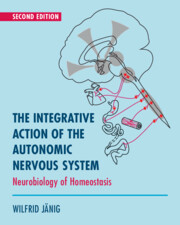Book contents
- The Integrative Action of the Autonomic Nervous System
- Reviews
- The Integrative Action of the Autonomic Nervous System
- Copyright page
- Dedication
- Contents
- Foreword to the Second Edition
- Foreword to the First Edition
- Preface
- Abbreviations
- Introduction The Autonomic Nervous System and the Regulation of Body Functions
- Part I The Autonomic Nervous System: Functional Anatomy and Interoceptive Afferents
- Chapter 1 Functional Anatomy of the Peripheral Sympathetic and Parasympathetic Systems
- Chapter 2 Interoceptive Afferent Neurons and Autonomic Regulation with Special Emphasis on the Viscera
- Part II Functional Organization of the Peripheral Autonomic Nervous System
- Part III Transmission of Signals in the Peripheral Autonomic Nervous System
- Part IV Representation of the Autonomic Nervous System in the Spinal Cord and Lower Brain Stem
- Part V The Centers of Homeostasis in the Mesencephalon and Hypothalamus and Their Telencephalic Control
- Index
- References
Chapter 1 - Functional Anatomy of the Peripheral Sympathetic and Parasympathetic Systems
from Part I - The Autonomic Nervous System: Functional Anatomy and Interoceptive Afferents
Published online by Cambridge University Press: 16 July 2022
- The Integrative Action of the Autonomic Nervous System
- Reviews
- The Integrative Action of the Autonomic Nervous System
- Copyright page
- Dedication
- Contents
- Foreword to the Second Edition
- Foreword to the First Edition
- Preface
- Abbreviations
- Introduction The Autonomic Nervous System and the Regulation of Body Functions
- Part I The Autonomic Nervous System: Functional Anatomy and Interoceptive Afferents
- Chapter 1 Functional Anatomy of the Peripheral Sympathetic and Parasympathetic Systems
- Chapter 2 Interoceptive Afferent Neurons and Autonomic Regulation with Special Emphasis on the Viscera
- Part II Functional Organization of the Peripheral Autonomic Nervous System
- Part III Transmission of Signals in the Peripheral Autonomic Nervous System
- Part IV Representation of the Autonomic Nervous System in the Spinal Cord and Lower Brain Stem
- Part V The Centers of Homeostasis in the Mesencephalon and Hypothalamus and Their Telencephalic Control
- Index
- References
Summary
The sympathetic and parasympathetic nervous systems are defined anatomically based on the levels of outflow from the spinal cord and brainstem. The sympathetic system originates from the thoracic and upper lumbar spinal segments and is therefore called the thoracolumbar system. The parasympathetic system originates from the brain stem and sacral spinal cord and is called the craniosacral system. Both systems consist of chains of preganglionic and postganglionic neurons, which are synaptically connected in autonomic ganglia. Sympathetic ganglia are situated away from their targets and organized bilaterally in the sympathetic chains and in the prevertebral ganglia. Parasympathetic ganglia are situated close to the target organs. Most autonomic target tissues react under physiological conditions to only one of the autonomic systems. The widely propagated idea of the antagonism between sympathetic and parasympathetic nervous systems is misleading. The adrenal medulla is an endocrine gland made up of cells releasing either adrenaline or noradrenaline. Postganglionic neurons of autonomic pathways contain combinations of neuropeptides colocalized with acetylcholine or noradrenaline. The principal organization of the peripheral autonomic nervous system in submammalian vertebrate groups is highly conserved in evolution over about 500 million years.
Keywords
- Type
- Chapter
- Information
- The Integrative Action of the Autonomic Nervous SystemNeurobiology of Homeostasis, pp. 9 - 33Publisher: Cambridge University PressPrint publication year: 2022

